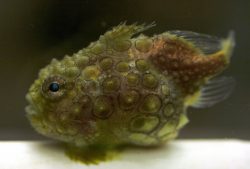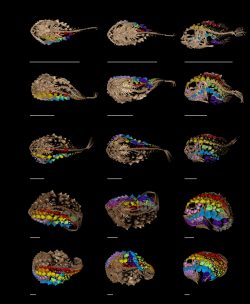
The ocean is full of otherworldly creatures, seemingly from alien planets with alien capabilities. In most cases, the award for craziest looking critter would go to an invertebrate. But many fish are contenders, too, and there’s an oddly adorable one common in northwest waters.
What does it look like? Imagine a golf ball. Now put some googly eyes on it and add a suction cup to its belly. Give it some fins so it can swim, albeit poorly. There you have it — Eumicrotremus orbis, the Pacific spiny lumpsucker, in all its glory.
“It’s such a cute, lovely, rotund fish that bounces around the intertidal,” says Karly Cohen, a biology graduate student doing doctoral research at the UW Friday Harbor Labs. Cohen has been studying the globe-shaped fish to better understand its natural history along with advisor Adam Summers.
But the lumpsucker has another oddity — it’s covered head to tail in armored spikes. Not much was previously known about the barnacle-looking lumps and bumps on the fish’s body, so Cohen and undergraduate Ella Woodruff took a closer look. Their findings were published in the Journal of Morphology, where Woodruff was the lead author on a team of four.
“The armor is protecting them against the pressures of the intertidal [like smashing into rocks and other hard objects] instead of for fighting,” Woodruff says. Armor is not uncommon in fish species, but the real discovery was the kind of armor the lumpsucker creates. “My favorite thing about them is that their armor is actually the same material as teeth. That is so incredible to me and so unexpected, that we found out their armor is made of enamel.”

The hard structures that cover the external surfaces of animals with a similar structure to teeth are called odontodes. They’re often lighter than the armor produced by some other fishes, yet the enamel still provides protection using one of the hardest biological materials known. This is good news for the lumpsucker, whose poor swimming abilities would only be exacerbated if its armor was heavy. And because its swimming leaves something to be desired — constantly at the will of currents, tides and waves — the armor is crucial as the fish collides with hard surfaces when going about its daily business.
“They are not born with the armor, they have to develop it,” says Woodruff. “The armor is non-overlapping, and each odontode starts with a singular cone that they add to in a spiral shape.” The odontodes are organized into eight rows — six rows on the body, another row surrounding the eye and one more underneath the chin.
Creating enamel does come with a cost. While other fishes’ armor is highly mineralized compared to the lumpuscker’s, it is believed that other fish can repair damaged plates. The lumpsucker cannot, and while the enamel on its ontododes is hard, it is not strong and can easily crack or be worn down over time. Nearly 100% of older lumpsuckers show signs of damage to their armor and do not have a way to fix it.
What’s novel about these findings are twofold, says Cohen. First, while mostly restricted to the mouth in bony fishes, scientists can look at the evolution of teeth that show up in unexpected ways, painting a bigger picture of how tools evolve and are used in different lineages. The second is how armor may bring additional benefits, like camouflage. If you look closely, the lumpsucker looks almost as if it’s covered in barnacles, a common invertebrate covering rocks and hard surfaces in the marine environment, which may help the fish blend in with its surroundings.
The list of oddities goes on for the Pacific spiny lumpsucker. That suction-cup disc on its belly? It allows them to hunker down in stormy seas, anchoring them to hard surfaces. Cohen says another cool thing, perhaps her favorite about them, is still a bit of a mystery. “Male lumpsuckers glow bright red all the time. When you look at them in normal light, they are red and purple, and they fluoresce bright red under UV light. And the disc on all lumpsuckers fluoresces bright yellow.” Cohen and her research team are trying to figure out why, along with other mysteries of this strange little fish.
Cohen, Woodruff and their colleagues were able to explore these questions using the Burke Museum’s fish collection, housed within the College of the Environment.

